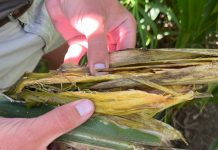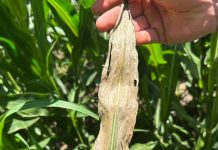
operations and
stewardship manager,
CropLife SA
3 June 2021 – All pesticides must be applied at a certain dosage rate that is unique to every product to ensure effective management (control) of the target organism.
The registration holder of a pesticide has gone through great pains and financial investment to arrive at the dosage that is printed on the product label. Failing to apply the pesticide at the given dosage in the directions for use, may result in ineffective control, or worse, phytotoxicity to the crop with resultant crop and financial losses for the producer.
Challenges of dosages given on most labels
The South African agriculture arena has seen a significant demographic change in the past decade, with many small farmers, self-sustaining farmers and home-garden farmers entering the sector. It is a very exciting development – the enthusiasm of these new entrants is fixating and warrants a nod of approval from government and civil society.
One of the biggest challenges for such farmers is to interpret label instructions, especially the dosage that is printed in the directions for use. For a large-scale commercial producer who cultivates large tracts of land with tractors and ground or aerial spray equipment, the dosage rate which is generally stated as quantity of the pesticide per hectare is no problem. However, for a farmer with an acre of maize or cabbages, it poses a real challenge if he/she has to convert pesticide quantity per hectare to the amount of pesticide that has to be poured into a knapsack spray holding 16 ℓ.
There is no golden rule or one-size-fits-all rule of thumb; every label must be read and interpreted before the conversion calculation can be made. That is because every pesticide has its own dosage and every label instructs the user on the spray volume per hectare.
Start from scratch
Calculus, or simple mathematics, need not be difficult if one unravels the calculations to its basic elements after which one systematically puts the elements together again to arrive at the desired results. The elements needed to calculate the quantity of pesticide in any volume of spray equipment, are as follows:
- The dosage per hectare. A strong hint here for efficacy, prevention of phytotoxicity and resistance development or sensitivity shift, is to work strictly according to the label’s directions for the dosage rate. Dosage may be anything from a few hundred millilitres (or a few hundred grams) per hectare to several litres (or several kilograms) per hectare.
- The recommended spray volume per hectare. This differs vastly between different pesticides,
between different crops and between different application technologies. - The surface area of the crop that needs to be sprayed. This surface area must be measured as accurately as possible to ensure that the correct dosage is applied to the crop field.
- The exact volume of the spray tank, which may range from a few litres (like 16 ℓ for a knapsack) to a few thousand litres for a large tractor-drawn boom spray.
Units of measure: a simple metric system
Due to the requirement of some farmers to only treat a small surface area, it is senseless to stick to kilograms or litres. Remember the following unit conversions:
- One kilogram equals 1 000 grams.
- One litre equals 1 000 millilitres.
- One hectare equals 10 000 square meters.
For small volume spray mixtures, such as hand sprays or knapsack sprays, always work on the gram/millilitre and square meter units of measure. It is even advisable for large volume spray mixtures to ensure accurate calculations.
The calculation: a stepwise approach to the correct measurements
-
- Calculate the total spray area (TSA) in units of hectares that is to be treated with the pesticide, by pacing it out as accurately as possible or measuring it with the aid of GPS coordinates if it is a large field. This should give a good and accurate estimate of the surface in square meters or hectares. For example, an area of 125 m long and 70 m wide will therefore be a TSA of 125 X 70 = 8 750 m2 which is 0,875 ha (8 750/10 000 = 0,875).

- Calculate the total spray volume (TSV) required (in units of hectares) to spray the TSA by multiplying the TSA by the label-directed spray volume (LSV) per hectare, for example 0,875 ha X 300 ℓ/ha = 262,5 ℓ.

- Calculate the total pesticide quantity (TPQ) measured in units of millilitres required for the TSA by multiplying the TSA by the label-directed dosage (LDD) per hectare measured in units of millilitres, for example 0,875 ha X 4 500 ml = 3 938 ml.

- Calculate the pesticide volume per spray tank (PVT) by dividing the spray tank volume (STV) in units of litres by the TSV and multiplying that by the TPQ, for example for a knapsack spray that holds a volume of 16 ℓ, the calculation is (16 ℓ ÷ 262,5) X 3,938 = 240 ml.

- Calculate the total spray area (TSA) in units of hectares that is to be treated with the pesticide, by pacing it out as accurately as possible or measuring it with the aid of GPS coordinates if it is a large field. This should give a good and accurate estimate of the surface in square meters or hectares. For example, an area of 125 m long and 70 m wide will therefore be a TSA of 125 X 70 = 8 750 m2 which is 0,875 ha (8 750/10 000 = 0,875).
Practical examples
For a large-scale commercial farm: A maize field of 421 ha must be sprayed with a pesticide at a dosage of 4,5 ℓ/ha in a volume of 300 ℓ spray mixtures per hectare. The volume of the tractor boom spray tank is 1 500 ℓ:
- TSA = 421 ha.
- TSV = TSA X LSV: Total spray volume is 421 X 300 = 126 300 ℓ total spray volume.
- TPQ = TSA X LDD: Total pesticide quantity is 421 X 4 500 ml = 1 894 500 ml or 1 895 ℓ (rounded off).
- PTV = (STV ÷ TSV) X TPQ: Pesticide per spray tank volume is (1 500 ÷ 126 300) X 1 895 = 22,5 ℓ per spray tank.
Take note: In this example, the 1 500 ℓ spray tank’s total spray volume must be dispensed over 5 ha (1 500 ℓ ÷ 300 ℓ/ha), which means 84,2 tanks of spray mixture will be sprayed out.
For a small farming operation: A cabbage field of 75 m by 120 m must be sprayed with a pesticide at 260 ml/ha in a spray mixture volume of 150 ℓ/ha by knapsack sprays that hold a volume of 16 ℓ:
- TSA = 75 X 120 = 9 000 m2 or 0,9 ha.
- TSV = TSA X LSV: Total spray volume is 0,9 X 150 = 135 ℓ total spray volume.
- TPQ = TSA X LDD: Total pesticide quantity = 0,9 X 260 ml = 234 ml.
- PTV = (STV ÷ TSV) X TPQ: Pesticide per spray tank volume is (16 ÷ 135) X 234 = 27,73 rounded off to 28 ml per spray tank.
Take note: For this small-scale operation, 8,5 tanks of spray mixture will be sprayed out (135 ℓ total spray volume ÷ 16 ℓ spray tank volume).
Please note that these examples are completely fictitious and are not related to any pesticide, any crop or any producer.
For more information, contact Dr Verdoorn at CropLife SA on 082 446 8946 or gerhard@croplife.co.za





























